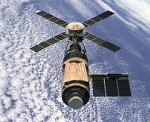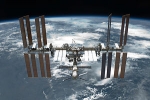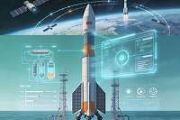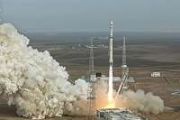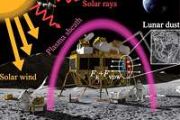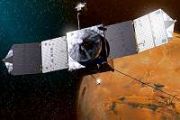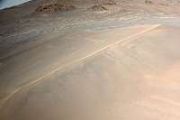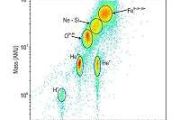Displaying items by tag: space station
Skylab
Skylab was a space station launched and operated by NASA (the space agency of the United States) and was the U.S.'s first space station.
Skylab orbited the Earth from 1973 to 1979, and included a workshop, a solar observatory, and other systems. It was launched unmanned by a modified Saturn V rocket, with a mass of 169,950 pounds (77 t). Three manned missions to the station, conducted between 1973 and 1974 using the Apollo Command/Service Module (CSM) atop the smaller Saturn IB, each delivered a three-astronaut crew. On the third mission, an additional Apollo / Saturn IB stood by, ready for launch if needed to rescue the crew in orbit.
Skylab included an Apollo Telescope Mount (a multi-spectral solar observatory), Multiple Docking Adapter with two docking ports, Airlock Module with EVA hatches, and the Orbital Workshop, the main habitable volume of the station. Power came from solar arrays, as well as fuel cells in the docked Apollo CSM. The rear of the station included a large waste tank, propellant tanks for maneuvering jets, and a heat radiator.
The station was damaged at launch when the micrometeoroid shield separated from the station and tore away, depriving the station of most of its power, removing protection from intense solar heating, and threatening to make the station unusable. The first crew was able to save it in the first ever in-space major repair, by deploying a replacement heat shade and freeing the single remaining, jammed main solar array.
Numerous scientific experiments were conducted aboard Skylab during its operational life, and crews were able to confirm the existence of coronal holes in the Sun. The Earth Resources Experiment Package (EREP), was used to view the Earth with sensors that recorded data in the visible, infrared, and microwave spectral regions. Thousands of photographs of Earth were taken, and records for human time spent in orbit were extended.
Plans were made to refurbish and reuse Skylab, using the Space Shuttle to boost its orbit and repair it. However, development of the Shuttle was delayed, and Skylab reentered Earth's atmosphere and disintegrated in 1979, with debris striking portions of Western Australia.
Galaxy (spacecraft)
Galaxy (previously Guardian) was a prototype space habitat designed by the American firm Bigelow Aerospace. It was intended to be the third spacecraft launched by the company in their efforts to create a commercial space station. Like other modules made by Bigelow Aerospace, Galaxy is based on the inflatable TransHab design by NASA, and was to be used for advanced systems testing before the company launched human-rated vehicles.
This project was cancelled in 2007.
International Space Station (ISS)
The International Space Station (ISS) is a habitable artificial satellite in low Earth orbit. It follows the Salyut, Almaz, Skylab and Mir stations as the ninth space station to be inhabited. The ISS is a modular structure whose first component was launched in 1998. Like many artificial satellites, the station can be seen from Earth with the naked eye. The ISS consists of pressurised modules, external trusses, solar arrays and other elements. ISS components have been launched by American Space Shuttles as well as Russian Proton and Soyuz rockets. Budget constraints led to the merger of three space station projects with the Japanese Kibō module and Canadian robotics. In 1993 the Soviet/Russian Mir-2, the American Freedom, and the European Columbus, merged into a single multi-national programme. The Russian Federal Space Agency plans to separate some of its modules from the Russian segment to form theOPSEK facility before the remainder of the station is deorbited.
The ISS serves as a microgravity and space environment research laboratory in which crew members conduct experiments in biology, human biology, physics, astronomy, meteorology and other fields. The station is suited for the testing of spacecraft systems and equipment required for missions to the Moon and Mars.
The station has been continuously occupied for 11 years and 121 days having exceeded the previous record of almost 10 years (or 3,644 days) held by Mir, in 2010. The station is serviced by Soyuz spacecraft,Progress spacecraft, the Automated Transfer Vehicle, the H-II Transfer Vehicle, and formerly the Space Shuttle. It has been visited by astronauts and cosmonauts from 15 different nations.
The ISS programme is a joint project between five participating space agencies, the American NASA, the Russian RKA, the Japanese JAXA, the European ESA, and the Canadian CSA. The ownership and use of the space station is established by intergovernmental treaties and agreements. The station is divided into two sections, the Russian orbital segment (ROS) and the United States orbital segment(USOS), which is shared by many nations. The ISS is maintained at an orbital altitude of between 330 km (205 mi) and 410 km (255 mi). It completes 15.7 orbits per day. The ISS is expected to remain in operation until at least 2020, and potentially to 2028.

